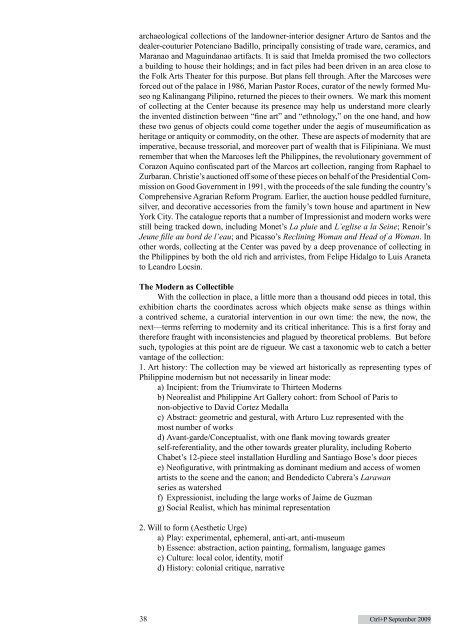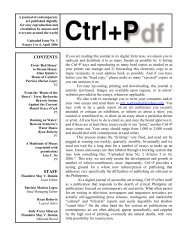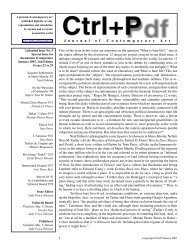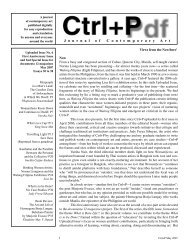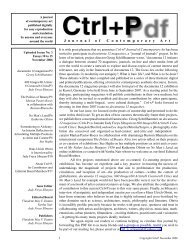Issue 15 - Pdf Ctrl+P - CTRL+P: a journal of contemporary art
Issue 15 - Pdf Ctrl+P - CTRL+P: a journal of contemporary art
Issue 15 - Pdf Ctrl+P - CTRL+P: a journal of contemporary art
Create successful ePaper yourself
Turn your PDF publications into a flip-book with our unique Google optimized e-Paper software.
archaeological collections <strong>of</strong> the landowner-interior designer Arturo de Santos and the<br />
dealer-couturier Potenciano Badillo, principally consisting <strong>of</strong> trade ware, ceramics, and<br />
Maranao and Maguindanao <strong>art</strong>ifacts. It is said that Imelda promised the two collectors<br />
a building to house their holdings; and in fact piles had been driven in an area close to<br />
the Folk Arts Theater for this purpose. But plans fell through. After the Marcoses were<br />
forced out <strong>of</strong> the palace in 1986, Marian Pastor Roces, curator <strong>of</strong> the newly formed Museo<br />
ng Kalinangang Pilipino, returned the pieces to their owners. We mark this moment<br />
<strong>of</strong> collecting at the Center because its presence may help us understand more clearly<br />
the invented distinction between “fine <strong>art</strong>” and “ethnology,” on the one hand, and how<br />
these two genus <strong>of</strong> objects could come together under the aegis <strong>of</strong> museumification as<br />
heritage or antiquity or commodity, on the other. These are aspects <strong>of</strong> modernity that are<br />
imperative, because tressorial, and moreover p<strong>art</strong> <strong>of</strong> wealth that is Filipiniana. We must<br />
remember that when the Marcoses left the Philippines, the revolutionary government <strong>of</strong><br />
Corazon Aquino confiscated p<strong>art</strong> <strong>of</strong> the Marcos <strong>art</strong> collection, ranging from Raphael to<br />
Zurbaran. Christie’s auctioned <strong>of</strong>f some <strong>of</strong> these pieces on behalf <strong>of</strong> the Presidential Commission<br />
on Good Government in 1991, with the proceeds <strong>of</strong> the sale funding the country’s<br />
Comprehensive Agrarian Reform Program. Earlier, the auction house peddled furniture,<br />
silver, and decorative accessories from the family’s town house and ap<strong>art</strong>ment in New<br />
York City. The catalogue reports that a number <strong>of</strong> Impressionist and modern works were<br />
still being tracked down, including Monet’s La pluie and L’eglise a la Seine; Renoir’s<br />
Jeune fille au bord de l’eau; and Picasso’s Reclining Woman and Head <strong>of</strong> a Woman. In<br />
other words, collecting at the Center was paved by a deep provenance <strong>of</strong> collecting in<br />
the Philippines by both the old rich and arrivistes, from Felipe Hidalgo to Luis Araneta<br />
to Leandro Locsin.<br />
The Modern as Collectible<br />
With the collection in place, a little more than a thousand odd pieces in total, this<br />
exhibition ch<strong>art</strong>s the coordinates across which objects make sense as things within<br />
a contrived scheme, a curatorial intervention in our own time: the new, the now, the<br />
next—terms referring to modernity and its critical inheritance. This is a first foray and<br />
therefore fraught with inconsistencies and plagued by theoretical problems. But before<br />
such, typologies at this point are de rigueur. We cast a taxonomic web to catch a better<br />
vantage <strong>of</strong> the collection:<br />
1. Art history: The collection may be viewed <strong>art</strong> historically as representing types <strong>of</strong><br />
Philippine modernism but not necessarily in linear mode:<br />
a) Incipient: from the Triumvirate to Thirteen Moderns<br />
b) Neorealist and Philippine Art Gallery cohort: from School <strong>of</strong> Paris to<br />
non-objective to David Cortez Medalla<br />
c) Abstract: geometric and gestural, with Arturo Luz represented with the<br />
most number <strong>of</strong> works<br />
d) Avant-garde/Conceptualist, with one flank moving towards greater<br />
self-referentiality, and the other towards greater plurality, including Roberto<br />
Chabet’s 12-piece steel installation Hurdling and Santiago Bose’s door pieces<br />
e) Ne<strong>of</strong>igurative, with printmaking as dominant medium and access <strong>of</strong> women<br />
<strong>art</strong>ists to the scene and the canon; and Bendedicto Cabrera’s Larawan<br />
series as watershed<br />
f) Expressionist, including the large works <strong>of</strong> Jaime de Guzman<br />
g) Social Realist, which has minimal representation<br />
2. Will to form (Aesthetic Urge)<br />
a) Play: experimental, ephemeral, anti-<strong>art</strong>, anti-museum<br />
b) Essence: abstraction, action painting, formalism, language games<br />
c) Culture: local color, identity, motif<br />
d) History: colonial critique, narrative<br />
38 <strong>Ctrl+P</strong> September 2009


